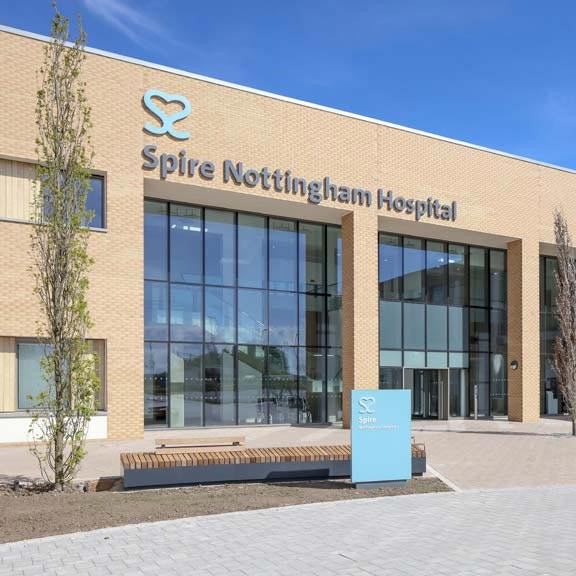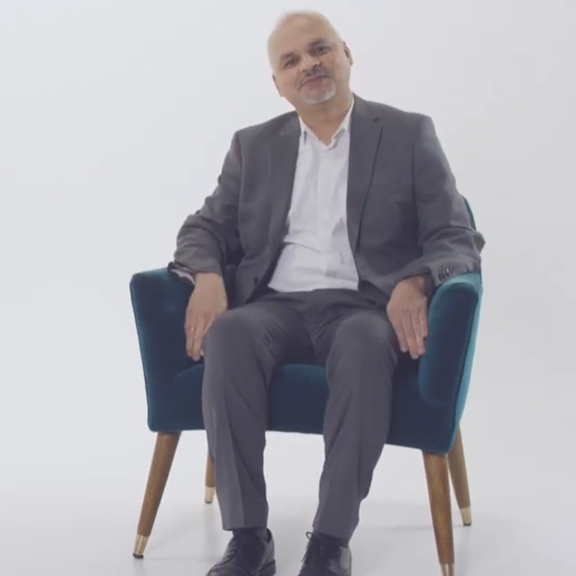Gallbladder / gallstone removal (cholecystectomy)
Keyhole surgery to remove your gallbladder because of a blocked bile duct.
We offer the latest surgical techniques and expert aftercare for gallbladder removal to relieve painful gallstones.
Sometimes also called
- Laparoscopic cholecystectomy
- Open cholecystectomy
At a glance
-
Typical hospital stay
0-1 nights for keyhole surgery 3-5 nights for open surgery -
Procedure duration
1-2 hours -
Type of anaesthetic
Usually general -
Available to self-pay?
Yes -
Covered by health insurance?
Yes
Why Spire?
- Fast access to diagnostic tests and scans
- Clear, inclusive pricing
- Direct booking
- Flexible visiting hours
What is gallbladder removal?
Gallbladder removal is a common operation that is often recommended if you are suffering from painful gallstones or gallbladder disease.
Your gallbladder is a small, pouch-like organ that stores and releases bile – a chemical substance that breaks down fats. You can easily live without your gallbladder, so if it’s causing problems your consultant may suggest removing it.
Gallstones are hard fatty lumps that form inside your gallbladder. They are often not painful, but sometimes they can cause more serious complications. This is known as gallbladder disease and includes:
- Blocked bile ducts
- Pancreatitis
- Inflamed gallbladder
When this happens, you may experience these symptoms:
- Sudden and intense pain in the upper right part of your abdomen
- Pain after eating
- Heartburn and indigestion
- A feeling of fullness and excess wind
- Nausea and vomiting
- High temperature
- Jaundice (a medical emergency)
Gallbladder removal will relieve pain and inflammation and prevent new gallstones forming.
It won’t affect your digestion because bile is made in your liver. Instead of being stored in your gallbladder, bile will drip straight from your liver into your digestive system.
Your consultant can diagnose gallbladder disease and decide if gallbladder removal is right for you by asking about your symptoms and medical history, and carrying out tests, including:
- Blood and urine tests
- Cholangiography – an X-ray using a dye to detect bile duct blockages
- Ultrasound scan
- CT scan
- MRI scan
Find your nearest Spire hospital
Almost all of our hospitals offer private gallbladder removal surgery. We have dedicated gastroenterologists (consultants specialising in the digestive system) who are highly skilled at this procedure and use many of the latest techniques and innovations.

How gallbladder removal surgery works
A gallbladder removal operation can either be done by laparoscopic (keyhole) surgery or traditional open surgery.
With keyhole gallbladder surgery, your surgeon will:
- Make small incisions (cuts) in your abdomen just under your ribs
- Insert gas into your abdomen (tummy) so they can see your gallbladder and surrounding organs more clearly
- Insert a laparoscope, a thin tube with a light and tiny camera, which sends images from inside your body to a video screen
- Insert tiny surgical instruments through your other incisions to remove your gallbladder
- Release the gas from your abdomen
- Stitch your incisions
With open gallbladder surgery, your surgeon will:
- Make one incision underneath your ribs
- Use normal-size surgical instruments to remove your gallbladder
- Close your wound with stitches
Keyhole surgery is usually the first choice because you recover faster and are left with smaller scars. But it’s not suitable for everyone. Your surgeon will explain which method is better for you and why.
Sometimes, even if keyhole surgery is planned, your surgeon may need to change this to open surgery during the operation, for instance if they can’t see your gallbladder clearly. They’ll explain this beforehand and answer any questions you may have.
Before the operation, you’ll have a pre-operative assessment to check your suitability for surgery and the anaesthetic.
What to expect during gallbladder removal surgery
Pre-operative assessment
In the days before your operation, you’ll have a pre-operative assessment with a nurse. At this appointment you may have blood tests and a general health check-up to ensure that you’re fit for surgery.
This appointment is a good opportunity for you to ask any questions and discuss any concerns you may have.
Preparing for gallbladder removal
At your pre-operative assessment, you’ll be told how to prepare for your operation. Typically, you must not eat for about six hours or drink for two hours before general anaesthesia. However, you will be told to avoid certain fluids (milk) and water or black tea or black coffee is usually recommended If you take any medications, you may also be given specific instructions to reduce your dose or stop taking them. You should stop smoking and drinking alcohol to help reduce your risk of having complications after surgery.
On the day
Once you arrive at the hospital, your surgical team will get your ready for surgery. You may need to wear compression stockings to help prevent blood clots forming while you’re lying still during the operation and inactive during your initial recovery.
A nurse will prepare you for surgery and take you to the theatre where a member of the theatre team will check your details and an anaesthetist will give you the anaesthetic. Your consultant surgeon will carry out the operation.
How long does a gallbladder removal operation take?
Between one and two hours for keyhole surgery, and often a little longer for open surgery.
Anaesthetic
Gallbladder removal surgery is nearly always carried out with a general anaesthetic, when you’re asleep. However, occasionally, it may be performed under regional anaesthetic (spinal or epidural anaesthetic) instead.
Pain after gallbladder removal
With keyhole gallbladder removal, there tends to be less pain after than with open surgery. However, you’re still likely to feel some discomfort once your anaesthetic wears off. Everyone experiences pain differently but you’ll be given painkillers to help you manage this afterwards.
Going home
If you have keyhole surgery, you’ll usually go home on the same day or the following day. If you have open surgery, you may be in hospital for three to five nights. You’ll be given instructions on how to care for your wounds and painkillers you can take to help with any pain.
You’ll need someone to drive you home after your operation and stay with you for 24 hours because you may still be feeling the effects of the anaesthetic.
Recovering from gallbladder removal surgery
Recovery time
Your gallbladder removal recovery will depend on the type of surgery you have. With keyhole surgery, you may make a full recovery within a couple of weeks. With open surgery, it could take around six to eight weeks.
For the first few days at home, you may want to arrange help with tasks such as shopping and cleaning, especially if you’ve had open surgery. You can take over-the-counter painkillers to help with any pain. If you had dissolvable stitches, they should disappear within a week or two. Non-dissolvable stitches will be removed by a nurse after seven to 10 days.
Your consultant will advise when you can get back to normal activities, including working and driving – it’ll usually be around 10 to 15 days after your operation. This will depend on the work you do and which type of surgery you have. You should also check with your motor insurance company before driving as some won’t insure you for a number of weeks after surgery. It’ll be at least a month until you can resume strenuous activities.
After a gallbladder removal, it’s normal to experience short term side effects such as:
- Bloating and wind
- Diarrhoea
- Fatigue, mood swings or irritability
- Nausea
- Pain in the shoulders
- Pain or soreness around your healing wounds and abdomen
- Swelling and bruising around your healing wounds
- Diarrhoea
Your diet after gallbladder removal
You can eat a normal diet after a gallbladder removal, though you may want to start with small meals. If you get temporary side effects such as wind, diarrhoea or indigestion, try:
- Limiting caffeine
- Limiting fatty and spicy foods
- Gradually increasing your fibre in the form of fruit and vegetables and whole grains
Treatment and recovery timeline
As a guide, here’s a typical recovery timeline for gallbladder removal surgery:

0-1 days
Leave hospital after keyhole surgery
3-5 days
Leave hospital after open surgery
10-14 days
Back to work, light activities and driving after keyhole surgery
4-8 weeks
Back to work, light activities and driving after open surgery
-
0-1 days
Leave hospital after keyhole surgery
-
3-5 days
Leave hospital after open surgery
-
10-14 days
Back to work, light activities and driving after keyhole surgery
-
4-8 weeks
Back to work, light activities and driving after open surgery
Risks and complications of gallbladder removal surgery
Most people have a gallbladder removal operation without complications, but all surgery carries some risks.
Your consultant will explain them to you before you go ahead.
You should consult your doctor if you experience any of the symptoms described below.
Infection
Infections may develop in the wound or internally after surgery. If this happens, you may experience increasing pain, swelling, redness and pus from the wound.
Bleeding
Although rare, bleeding can occur after an operation, often requiring further surgery to stop it.
Bile leakage into your abdomen
When your gallbladder is removed, your surgeon will attach clips to the tube connecting the main bile duct to prevent bile from leaking out into your abdomen. However, if it leaks, you may feel symptoms such as abdominal pain and/or swelling, nausea or fever. The fluid can either be drained using a large needle or through an operation to wash out the inside of your abdomen.
Damage to a bile duct
This can mean that bile leaks into your abdomen or normal flow from your liver is blocked. If this happens, you may need further surgery after your original operation. Symptoms include:
- Abdominal pain or swelling
- Chills
- Fever
- General discomfort
- Jaundice – yellowing of the skin and eyes
- Nausea and vomiting
Accidental injury to surrounding tissues
This includes your stomach, intestines, bowel and blood vessels. Your surgeon will usually repair the damage at the time of the operation. If any damage isn’t spotted, then you’ll likely need another operation to fix it.
Blood clots in your veins
Also called deep vein thrombosis, this usually occurs in a leg vein and is why you’ll often be given compression stockings to wear during and after surgery. If a blood clot in a vein comes loose and flows around your body to your lungs, it’s called a pulmonary embolism. Symptoms of a pulmonary embolism include pain in your chest or upper back, difficulty breathing, coughing up blood, fast heartbeat and passing out. This is a medical emergency, so you should call 999 or go to A&E.
Post-cholecystectomy syndrome
This is when gallstones are left in your bile duct or bile leaks into your stomach. Symptoms include:
- Abdominal pain
- Diarrhoea
- Fever
- Indigestion
- Jaundice – yellowing of the skin and eyes
Usually, symptoms don’t persist but sometimes can last for several months. If symptoms are a long-term problem for you, you may be given medication or a further procedure to remove any remaining gallstones.
Risks of general anaesthetic
Serious complications associated with general anaesthetic do occur, but they're extremely rare. For most people, the benefits in terms of controlled unconsciousness and removal of pain are much greater than the disadvantages. It’s estimated that serious complications result in approximately four deaths for every million anaesthetics given. The pre-operative assessment is carried out to limit the risk of any complications occurring.
At Spire hospitals, your safety is our top priority. We have high standards of quality control, equipment and cleanliness and an ongoing system of review and training for our medical teams.
Frequently asked questions
Do I need to adjust my diet after gallbladder removal?
You can eat normally after gallbladder removal, though you may want to start with small meals.
If you get temporary side effects such as wind, diarrhoea or indigestion, try:
- Limiting caffeine
- Limiting fatty and spicy foods
- Gradually increasing your fibre in the form of fruit and vegetables and whole grains
Can I drink coffee after gallbladder removal?
You can eat and drink normally after gallbladder removal. However, if you find you have side effects such as wind, diarrhoea or indigestion, limiting caffeine (for example coffee, tea and some fizzy drinks) can help.
When can I go back to work after surgery?
You can usually return to work around 10-15 days after your operation. It may be longer if you had open surgery rather than keyhole surgery.
Can gallbladder surgery cause diarrhoea?
Diarrhoea is a temporary side effect of gallbladder removal and it can last a few weeks. To help, you can try eating a high-fibre diet that includes fruit, vegetables, brown rice and wholemeal bread. Your GP can also help by prescribing you medication if needed.
If it continues or you have other symptoms as well (such as abdominal pain, fever, nausea, jaundice), you should consult your doctor.
What is an ERCP procedure?
An ERCP procedure stands for endoscopic retrograde cholangio pancreatography. It’s a test used to examine your liver, bile ducts, pancreas or gallbladder using a thin, flexible tube with a small camera and a light at the end (an endoscope). The tube is passed through your mouth and into your stomach and small bowel (also called your upper intestine or duodenum). You’ll also have X-rays taken of your pancreas, gallbladder and bile ducts.
What are the side effects of having your gallbladder removed?
After a gallbladder removal, it’s normal to experience:
- Bloating and wind
- Diarrhoea
- Fatigue, mood swings or irritability
- Nausea
- Pain in the shoulders
- Pain or soreness around your wounds and abdomen
- Swelling and bruising around your healing wounds
These should disappear after a few days to a few weeks.
Is having your gallbladder removed major surgery?
Gallbladder removal is considered a major general surgical operation. It’s a common procedure – one of the most commonly performed in the UK.
Can having your gallbladder removed make you gain weight?
Some people find they gain weight after gallbladder removal, however, it’s unclear why this happens. Some researchers believe this may be due to people returning to unhealthy eating habits that may have contributed to them developing gallstones or gallbladder disease – this is because being overweight is a risk factor.
The treatment described on this page may be adapted to meet your individual needs, so it's important to follow your healthcare professional's advice and raise any questions that you may have with them.
Get in touch
Sources
https://www.mayoclinic.org/tests-procedures/cholecystectomy/about/pac-20384818
https://www.nhs.uk/conditions/gallbladder-removal/what-happens/
https://www.healthline.com/health/gallbladder-removal-open
https://www.bupa.co.uk/health-information/digestive-gut-health/gallstones
https://www.everydayhealth.com/gallbladder/diagnostic-tests-for-gallbladder-disease.aspx

